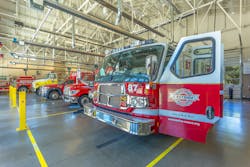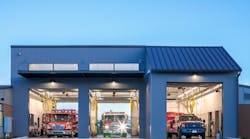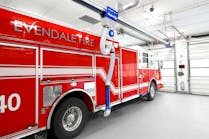Confronting Fire Department Diesel Exhaust Exposure Concerns - Part 5: Maximizing Your Resources
In Part 5 of this six-part series, we will look at mitigating strategies and current systems on the market that attempt to "close the door" on exposure pathways within your station as discussed in Part 4 of this series. Following the analysis and categorization of exposure pathways, more than likely your happy bubble (that everything is fine) has been popped. You probably have some work that needs to be done.
Whether you have an existing station or are planning a new station, the next step in the evaluation process is to conduct a detailed survey and assessment of what mitigating measures are in place, or can be put into place, at each potential exposure pathway. These may consist of administrative protocols, installed or planned building systems, and existing or new building design considerations (or some combination thereof). Think of this effort as the next step in a strategic planning process that starts with your current baseline, establishes prioritized objectives for improving the situation, explores alternative strategies to achieving those objectives, and recommends a hierarchy of tasks and necessary timeline, as budget allows.
Your existing ventilation systems to consider may include dilution ventilation, source capture and downdraft. For each, consider the effects of air currents or disruptions to airflow, the effectiveness of protocols for use, firefighter acceptance, operational costs, and maintenance requirements and resources. Focus on the potential weak points in each system—failure to follow exhaust management procedures, poorly serviced apparatus, broken, rapidly changing or new equipment, reserve apparatus and move-ups, propping open doors, and delayed service calls. Even a mindset that it is someone else’s problem should be considered.
Don’t forget to consider the ventilation system serving the living quarters and the pressure differentials between offices and living quarters, apparatus support areas, and the apparatus room.
Look for gaps in coverage, as well as in information or understanding. Air monitoring (which we will write about in Part 6 of this series) or other testing may be useful. Remember, you may sometimes be able to shut the door completely on an exposure pathway, but many times, the best you can do is to close it partially. And that may be sufficient!
From here, you can begin to examine what if any additional control options might be needed, and to prioritize decisions and targeted goals across the entire spectrum of risk. Take into account the size of your effort as it relates to airborne-exposure reduction, implementation complexity, departmental disruption, and expenditures. When considering ventilation and exhaust discharge, don’t forget your lessons in thermodynamics. The movement of diesel particulates in both the indoor and outdoor environments will depend on temperature differentials, local wind patterns, pressure differentials, building envelope behavior, etc. Be aware of how and where the exhaust is being filtered, diluted, and exhausted. You don’t want it to blow back into the station or to be re-entrained through a building air intake, window, or doorway that is too close to an exhaust outlet.
Focusing specifically on diesel exhaust control through ventilation and filtration, there are many available products on the market; however, you should be aware that none “shuts and seals the door entirely.” These diesel exhaust capture methodologies can be broken into two categories. With one system, the firefighter takes an active role, such as when using an exhaust pipe-mounted source capture exhaust system. With the other, the firefighter has no active role. The latter include downdraft systems and all bay filtration/dilution systems. Each system has its strengths and weaknesses, but all can be used to meet current minimal ventilation requirements if designed correctly.
Source capture (exhaust pipe connection)
- Good capture at the source via hose, automatic activation and disconnect
- Active user role. Auto-start. Hose must be attached to the apparatus exhaust each time, with an opportunity for human error
- Must be engineered to have sufficient capture velocity at point of exhaust
- Connecting the hose brings the breathing zone close to the engine exhaust
- Potential for backwash when the apparatus leaves the bay
- Maintenance—service and repair timing can be an issue
- May not be easily adaptable for new or visiting apparatus
Downdraft exhaust (or hybrid mechanical systems)
- Passive user role. Activation by tone, ignition or door movement. Lessens chance of human error
- Not as commonly used or well tested as other systems
- Dilution ventilation and cross drafts (doors opening and closing) can interfere with functionality
- Must be designed to have sufficient capture velocity at or near point of exhaust
- Only effective for floor-level apparatus exhaust
- Heat loss issues without energy recover system
- Not easily installed in existing stations
Filtration-Dilution (ceiling hung)
- Passive user role. Auto start. Lessens opportunity for human error
- Allows for complete apparatus flexibility in bay
- No bay heat loss due to recirculation. Filters some bay contaminants but others may be more difficult to remove from the air stream
- Contaminants are drawn through breathing zone and some level of contamination remains essentially constantly
- Requires the most air to be handled and treated
- Can act as interference when used in conjunction with another method, particularly if not carefully designed to work together
- Effective filter replacement program required
Another type of diesel exhaust control is an engine exhaust filtration system. This system is not bay ventilation but can act in concurrence with one or more types of bay filtration.
Engine Exhaust Filtration (mounted on apparatus)
- Passive user role. Auto-engagement. Lessens opportunity for human error
- No equipment hanging in the bay
- Reported 80-95 percent-plus reduction in soot contained in exhaust, with additional gaseous contaminant reduction depending on system type
- Reduction of toxins on scene via on-site manual override which keeps system in filter mode
- All apparatus in bay must have a vehicle-mounted filter
- Filter replacement every 2-3 years, with servicing required based on use
- Potential influence on exhaust systems according to some, but does not void engine warranties
Since no off-the-shelf solution solves all issues, it may make sense to double-up systems or implement hybrid solutions based on your unique circumstances. You should consider cost, local serviceability and availability, mechanical and energy codes, weather, microclimate and existing equipment and apparatus type. At a minimum, there should be positive pressure in the living areas and negative pressure in the apparatus bays, weather seals and self-closing doors between these areas, and regular apparatus maintenance to minimize the source impact.
Of critical importance, whatever system(s) you implement, is to ensure that the complete mitigation system is inspected, tested, and serviced on a regular basis. It should be consistently used as designed and implemented, to maximize its effectiveness. And re-evaluation of the system at appropriate milestones must be part of your contaminant control program.
Finally, to comprehensively address all firefighter contaminant exposure potentials, and exposure pathways through the station, you must consider the risks associated with contaminated turnout gear and hoses. Although this issue is not addressed in detail in this series, which focuses primarily on the hazards related to diesel exhaust, a stand-alone article on this topic is planned that will go into detail on what those risks are, both from off-gassing of volatile contaminants and skin contact with non-volatile contaminants, and ways to minimize those risks. In the meantime, NFPA 1851 (2014), the Standard on Selection, Care, and Maintenance of Protective Ensembles for Structural Fire Fighting and Proximity Fire Fighting, is an excellent source of how to mitigate these risks.
In Part 6, we will consider your options for verification of control effectiveness, including air testing, which is a critical tool for verification of employee safety. We will also consider program documentation and communication with employees and other stakeholders.
Related Articles:
- Confronting Fire Department Diesel Exhaust Exposure Concerns - Part 1
- Confronting Fire Department Diesel Exhaust Exposure Concerns - Part 2: Taking a Systems Approach
- Confronting Fire Department Diesel Exhaust Exposure Concerns—Part 3: Determining Exposure Sources
- Confronting Fire Department Diesel Exhaust Exposure Concerns - Part 4: Evaluating Exposure Pathways
- Confronting Fire Department Diesel Exhaust Exposure Concerns - Part 5: Maximizing Your Resources
- Confronting Fire Department Diesel Exhaust Exposure Concerns - Part 6: Air Testing & Communication of Exposure Results
- Confronting Turnout Gear, Equipment Contamination in the Fire Station










